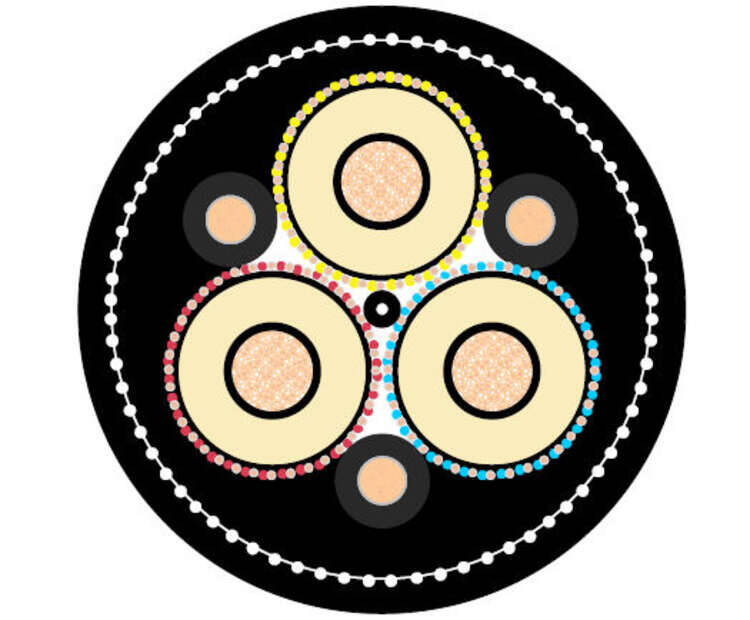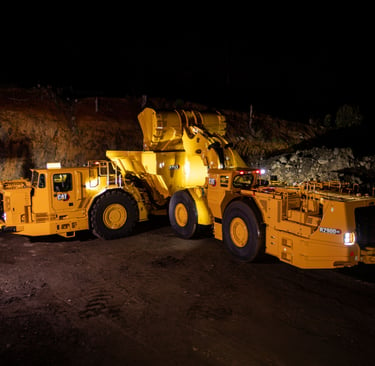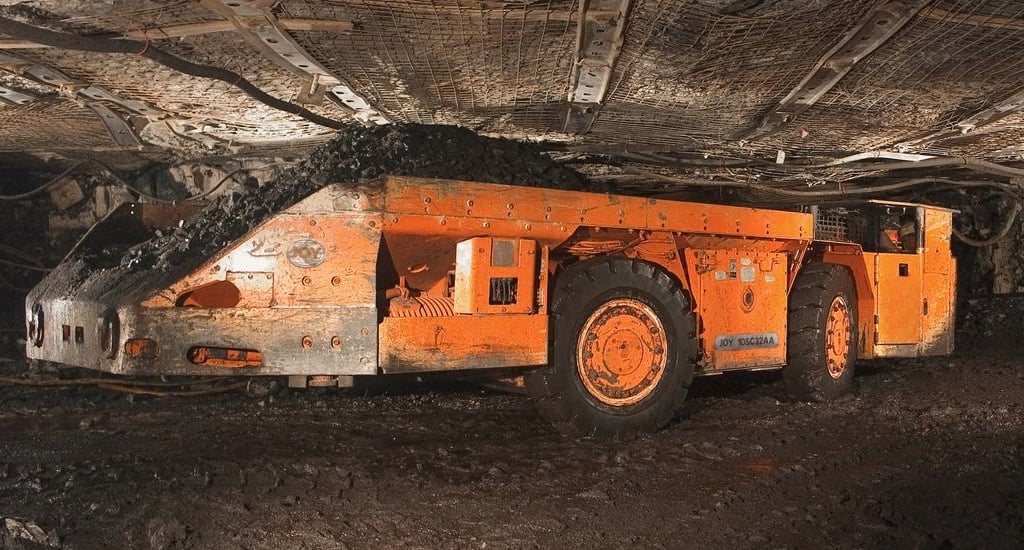Anhui Feichun Special Cable Co.,Ltd Li.wang@feichuncables.com
Powering the Depths: How SANS Type 611 and 611-ECC Cables Keep South Africa's Mines Running Safely
Discover why SANS Type 611 and 611-ECC 6.35/11 kV mining cables are essential for South African mining operations. Learn about their construction, applications, and safety features in underground and open-pit mines.
Li.wang@Feichun Cable
7/28/202510 min read


Introduction: Powering South African Mines Safely
South Africa's mining industry remains the backbone of the nation's economy, contributing significantly to GDP and employment across the country. From the deep gold mines of the Witwatersrand to the expansive platinum operations in the Bushveld Complex and coal mines in Mpumalanga, these operations require robust and reliable power distribution systems that can withstand the harshest conditions imaginable.
The challenge of delivering electrical power safely and efficiently in mining environments cannot be overstated. Deep-level mines, some extending over 4,000 metres below surface, present unique electrical distribution challenges. Similarly, open-pit operations with their massive mobile equipment require flexible, durable cabling solutions that can handle continuous movement and extreme mechanical stress.
Medium voltage cables form the critical link in mining power distribution networks, carrying electricity from surface substations to underground workings and mobile equipment. These cables must not only deliver power reliably but also meet stringent safety requirements to protect miners and equipment in potentially hazardous environments.
Compliance with South African National Standards (SANS) and National Regulator for Compulsory Specifications (NRCS) requirements is not optional – it's a legal and operational necessity. The SANS 1520-2 standard specifically addresses medium voltage cables for mining applications, ensuring they meet the rigorous demands of South African mining conditions.
This is where SANS Type 611 and 611-ECC cables excel. These purpose-built mining cables represent decades of engineering expertise specifically designed for the unique challenges of South African mining operations. Whether powering underground shuttle cars in a gold mine or feeding electricity to massive draglines in an open-pit coal operation, these cables provide the reliability and safety that modern mining demands.
Understanding SANS Type 611 and 611-ECC Cables
What Are They?
The SANS Type 611 cable is a flexible, medium voltage trailing cable specifically engineered for mining machinery and portable apparatus. Its design addresses the fundamental requirement for power cables that can withstand the mechanical abuse, chemical exposure, and thermal cycling common in mining environments.
The Type 611 cable features a robust multi-layer construction that balances flexibility with durability. This makes it ideal for applications where cables must be frequently moved, coiled, or subjected to mechanical stress – common scenarios in both underground and surface mining operations.
The SANS Type 611-ECC variant takes safety a step further by incorporating Earth Continuity Conductors (ECC). These additional conductors provide enhanced earth fault protection, creating a more robust earthing system that significantly improves personnel safety and equipment protection. In mining environments where electrical safety is paramount, the ECC variant offers an additional layer of protection against potentially fatal electrical faults.
The ECC system works by providing a dedicated low-resistance path for fault currents, ensuring rapid detection and isolation of earth faults. This is particularly crucial in underground mining where miners work in close proximity to electrical equipment and where environmental conditions can compromise traditional earthing systems.
Voltage Rating & Construction
SANS Type 611 and 611-ECC cables are rated for 6.35/11 kV operation, making them suitable for medium voltage distribution networks commonly found in mining operations. This voltage rating provides an optimal balance between power transmission capacity and safety considerations.
The cable construction follows a sophisticated multi-layer approach:
Conductor: The heart of the cable features Class 5 flexible stranded tinned annealed copper conductors. This construction provides excellent flexibility while maintaining low electrical resistance. The tinning process protects the copper from corrosion, extending cable life in harsh mining environments. Available conductor sizes range from 25mm² to 240mm², accommodating various power requirements from small equipment feeds to major machinery connections.
Insulation: EPR (Ethylene Propylene Rubber) thermosetting compound provides the primary insulation. EPR offers excellent electrical properties, thermal stability up to 90°C, and superior resistance to ozone and weathering. The insulation system includes a strippable semi-conducting core screen in a triple-extruded configuration, ensuring uniform electrical stress distribution.
Screening: Each power core is individually screened with tinned copper and textile braid. This screening system ensures electromagnetic compatibility and provides an earthing path for electrical faults. The tinned copper construction resists corrosion while maintaining excellent electrical conductivity.
Pilot Cores: Three insulated pilot cores using EPM (Ethylene Propylene Monomer) insulation are laid up with the power cores. These pilot cores carry control and monitoring signals essential for modern mining equipment operation.
Inner Sheath: CR (Polychloroprene Rubber) provides mechanical protection and chemical resistance. This layer protects the internal cable components from moisture, oils, and other contaminants common in mining environments.
Reinforcement: An open nylon braid with minimum 16 strings provides mechanical strength and flexibility. This reinforcement allows the cable to withstand the pulling forces and mechanical abuse encountered in mining applications.
Outer Sheath: The final CR outer sheath in black provides ultimate protection against mechanical damage, UV radiation, oil, and chemical exposure. The black colour provides UV resistance for surface applications while maintaining visibility for safety identification.
Compliance and Certification
SANS Type 611 and 611-ECC cables fully comply with SANS 1520-2, SANS 1411-1, and SANS 1411-3 standards. These standards ensure the cables meet specific requirements for mining applications, including flame retardancy, mechanical strength, and electrical performance.
NRCS approval confirms these cables meet South African regulatory requirements for mining operations. This certification is essential for legal compliance and insurance purposes, ensuring mining operators can confidently deploy these cables in their operations.
The cables' flame retardant design meets stringent fire safety requirements crucial in confined mining environments. Combined with low smoke emission characteristics, these cables help maintain safe evacuation routes during fire emergencies.
Impact resistance ensures reliable operation despite the mechanical abuse common in mining operations. UV protection allows surface use without degradation, while oil resistance prevents deterioration from hydraulic fluids and lubricants commonly encountered around mining equipment.
Typical Applications in Mining
Underground Mining Operations
In underground mining, SANS Type 611 and 611-ECC cables serve as the lifeline for essential equipment. Longwall mining operations, common in South African coal mines, require reliable power distribution to complex shearer and conveyor systems. These cables provide the flexibility needed for the continuous advance of longwall faces while maintaining electrical integrity under enormous mechanical stress.
Shuttle cars, the workhorses of underground coal transportation, depend on flexible trailing cables that can withstand constant reeling and unreeling as they traverse underground roadways. The robust construction of Type 611 cables ensures reliable power delivery despite the harsh conditions and frequent movement.
Underground pump stations, critical for mine dewatering, require cables that can operate reliably in high-humidity environments with potential water exposure. The moisture-resistant construction of these cables ensures continuous operation of essential dewatering systems, preventing potentially catastrophic flooding.
In deep-level gold mines, these cables power various underground equipment including development headings, rock winders, and ventilation systems. The cables' ability to operate at temperatures up to 90°C makes them suitable for the elevated temperatures encountered at extreme depths.
Open-Pit Mining
Open-pit mining operations present unique challenges requiring cables that combine mechanical strength with flexibility. Large mobile equipment such as draglines, with their massive bucket capacities exceeding 100m³, require substantial power feeds that can accommodate the continuous movement and positioning of these giants.
Electric rope shovels, increasingly common in South African coal and iron ore operations, demand cables capable of handling both the electrical load and the mechanical stress of constant operation. The reinforced construction of Type 611 cables provides the durability needed for these demanding applications.
Continuous miners and other mobile equipment benefit from the cable's excellent reeling characteristics. The minimum bending radius of 9 times the overall diameter ensures the cable can be wound onto cable reels without damage, extending operational life and reducing maintenance requirements.
The UV-resistant outer sheath proves invaluable in South Africa's intense sunlight, preventing degradation that could compromise cable integrity and create safety hazards.
Surface Infrastructure
Mining surface infrastructure relies heavily on robust cable systems for crushers, mills, and processing equipment. These applications often involve exposure to abrasive dust, chemical processing agents, and mechanical vibration – conditions where Type 611 cables excel.
Conveyor systems, stretching for kilometres in some operations, require cables that can withstand environmental exposure while maintaining reliable power transmission. The oil-resistant properties prove essential around conveyor drive systems with their associated hydraulic and lubrication systems.
Mineral processing plants, with their complex array of equipment from jaw crushers to flotation cells, benefit from the cable's chemical resistance and mechanical durability. The ability to withstand both electrical and mechanical stress ensures reliable operation of critical processing equipment.
Key Performance Features
SANS Type 611 and 611-ECC cables deliver exceptional performance through carefully engineered features that address the specific challenges of mining applications.
High Mechanical Strength and Flexibility: The combination of flexible copper conductors, robust insulation systems, and reinforced construction provides cables that can withstand enormous mechanical stress while maintaining the flexibility needed for mobile applications. Maximum tension ratings up to 29.3 kN demonstrate the cable's ability to handle substantial pulling forces during installation and operation.
Moisture and Oil Resistance: The CR sheath construction provides excellent resistance to water, hydraulic fluids, and lubricating oils commonly encountered in mining environments. This resistance prevents sheath degradation that could compromise cable integrity and create safety hazards.
Fire Performance: Flame retardant properties ensure cables will not propagate fire, while low smoke emission characteristics maintain visibility during emergency evacuation. These features are particularly crucial in confined underground spaces where smoke accumulation could prove fatal.
Thermal Stability: Operating temperature ratings from -25°C to +90°C accommodate the extreme temperature variations encountered in South African mining operations, from the frigid conditions of high-altitude mines to the intense heat of deep underground workings.
ECC Enhanced Protection: In the 611-ECC variant, embedded earth continuity conductors provide superior fault protection. Short circuit ratings up to 29.3 kA for symmetrical faults and enhanced earth fault current capabilities ensure rapid fault detection and clearance, protecting both personnel and equipment.
The cables' electrical characteristics demonstrate their suitability for demanding mining applications. Current ratings ranging from 105A to 400A accommodate various load requirements, while low conductor resistance minimizes power losses and reduces operating costs.
Why Choose 611/611-ECC for South African Mines?
South African mining operations face unique challenges that make SANS Type 611 and 611-ECC cables the preferred choice for discerning operators. The country's mining geology, from the hard rock conditions of the Witwatersrand to the challenging coal seams of the Highveld, demands cables that can perform reliably under extreme conditions.
Proven Performance in Local Conditions: These cables have demonstrated exceptional performance in South Africa's major mining operations. Platinum mines in the Bushveld Complex, operating at depths exceeding 1,500 metres, rely on Type 611 cables for powering essential underground equipment. The cables' proven track record in these demanding conditions provides confidence for new installations.
Coal mining operations, particularly in Mpumalanga and KwaZulu-Natal provinces, have benefited from the cables' durability and reliability. Recent expansions at major coal operations have specified Type 611-ECC cables for their enhanced safety features, recognizing the importance of personnel protection in underground environments.
Gold mining operations, despite facing economic challenges, continue to rely on these cables for their deep-level operations. The cables' ability to operate reliably at extreme depths while maintaining safety standards makes them essential for these challenging applications.
Designed for African Conditions: South Africa's unique environmental conditions, including extreme temperature variations, intense UV radiation, and challenging geological conditions, require cables specifically designed for these demands. Type 611 cables' UV-resistant outer sheath prevents degradation under the African sun, while their temperature rating accommodates the extreme conditions from surface to deep underground.
The cables' oil and chemical resistance proves essential in South African mining operations where various processing chemicals and hydraulic fluids are commonly used. This resistance prevents premature cable failure and reduces maintenance requirements.
Reduced Downtime and Long Operational Life: Mining operations cannot afford extended downtime due to cable failures. Type 611 cables' robust construction and quality materials ensure extended operational life, reducing the frequency of cable replacements and associated downtime costs.
The cables' excellent splicing and termination characteristics allow for quick repairs when necessary, minimizing operational disruption. This is particularly important in underground operations where cable access may be limited and replacement costs are significant.
Regulatory Compliance and Safety: SANS and NRCS compliance ensures mining operators meet all legal requirements, avoiding potential regulatory issues and insurance complications. The enhanced safety features, particularly in the ECC variant, provide additional protection for personnel and equipment, reducing the risk of electrical accidents.
Recent safety initiatives in South African mining have emphasized the importance of electrical safety, making the enhanced earth fault protection provided by ECC variants increasingly valuable for forward-thinking operators.
Frequently Asked Questions (FAQs)
Q: What's the difference between Type 611 and 611-ECC cables? A: The primary difference is that 611-ECC cables include embedded Earth Continuity Conductors (ECC) that provide enhanced earth fault protection. While standard Type 611 cables rely on the metallic screening for earthing, the ECC variant includes dedicated low-resistance conductors specifically for fault current conduction, offering superior personnel and equipment protection.
Q: Can these cables be used in both underground and surface applications? A: Yes, SANS Type 611 and 611-ECC cables are designed for versatile use in both underground and surface mining applications. The UV-resistant outer sheath makes them suitable for surface use, while their robust construction and flame retardant properties make them ideal for confined underground spaces.
Q: What conductor sizes are available? A: Conductor sizes range from 25mm² to 240mm², accommodating various power requirements from small equipment feeds to major machinery connections. Each size is available in both standard Type 611 and ECC variants, providing flexibility in system design.
Q: How do I determine the appropriate cable size for my application? A: Cable sizing depends on several factors including load current, cable length, voltage drop requirements, and installation conditions. Current ratings range from 105A for 25mm² conductors to 400A for 240mm² conductors at 30°C ambient temperature. Professional electrical engineering consultation is recommended for optimal sizing.
Q: Are these cables suitable for reeling applications? A: Yes, the flexible construction with a minimum bending radius of 9 times the overall diameter makes these cables excellent for reeling applications. This characteristic is particularly important for mobile mining equipment requiring continuous cable movement.
Q: What maintenance is required for these cables? A: Regular visual inspection for mechanical damage, thermal monitoring of connections, and periodic electrical testing are recommended. The robust construction minimizes maintenance requirements, but proper handling and installation procedures should be followed to maximize cable life.
Q: How do these cables perform in high-temperature environments? A: Type 611 and 611-ECC cables are rated for continuous operation at temperatures up to 90°C, making them suitable for the elevated temperatures encountered in deep underground mining operations. The EPR insulation system provides excellent thermal stability.
Q: Can damaged cables be repaired? A: Yes, these cables can be repaired using appropriate splicing techniques and materials. However, repairs should only be undertaken by qualified personnel using approved methods to maintain the cable's safety and performance characteristics.
Conclusion: Investing in Safe and Reliable MV Cable Infrastructure
As South Africa's mining industry continues to evolve and face new challenges, the importance of reliable electrical infrastructure cannot be overstated. SANS Type 611 and 611-ECC cables represent more than just power transmission solutions – they are essential components of a safe, efficient, and compliant mining operation.
The investment in quality medium voltage cables pays dividends through reduced downtime, enhanced safety, and long-term operational reliability. In an industry where every hour of production matters, the robust construction and proven performance of these cables provide the foundation for successful mining operations.
The enhanced safety features, particularly in the ECC variant, align with the industry's increasing focus on personnel protection and regulatory compliance. As South African mining operations strive to achieve zero harm objectives, every component of the electrical system must contribute to overall safety performance.
Looking ahead, the mining industry's continued reliance on electrical power for increasingly sophisticated equipment makes the choice of cable infrastructure even more critical. SANS Type 611 and 611-ECC cables, with their proven track record and compliance with local standards, provide the reliable foundation needed for future mining success.
Mine operators who prioritize SANS-compliant cables demonstrate their commitment to safety, regulatory compliance, and operational excellence. This investment in quality infrastructure not only meets current regulatory demands but also positions operations for future success in an increasingly competitive and regulated industry.
The choice is clear: for South African mining operations demanding the highest levels of performance, safety, and reliability, SANS Type 611 and 611-ECC cables deliver the proven solution that keeps mines running safely and efficiently, powering the depths of South Africa's mining future.







Email Address: Li.wang@feichuncables.com
© 2025. All rights reserved.


One-click to Quickly Contact
Products
Offshore & Marine Cable
XLPE Cable
Contact
Company
Location:
Building A Private Science and Technology Park, Hefei Economic and Technological Development Zone, Anhui Province, China
